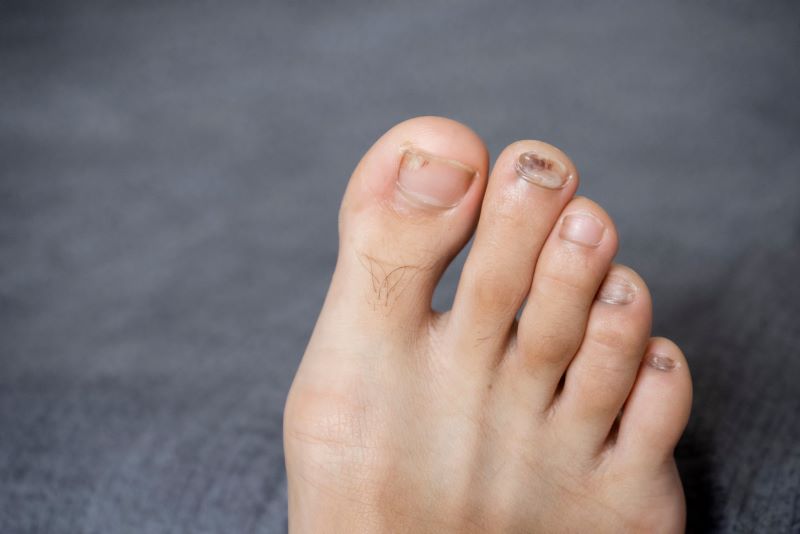Toenail fungus is an extremely common affliction. An estimated 14% of people in North America have toenail fungus, according to an article published in the journal PLoS Pathogens. Not only is toenail fungus common, but it also gets even more common as you get older. So if you searched “is toenail fungus common?” you are certainly not alone.
 Is Toenail Fungus Common?
Is Toenail Fungus Common?
Toenail fungus is an extremely common foot condition. According to the American Academy of Family Physicians, onychomycosis occurs in 10% of the general population. That’s one in every ten people! The likelihood of being diagnosed with toenail fungus increases as you get older. So chances are, you are not the only person you know to experience toenail fungus. Let’s discuss everything you need to know about toenail fungus:
What is Toenail Fungus?
Toenail fungus, also called onychomycosis in the medical world, is a widespread fungal infection that affects the toenails. If you have toenail fungus, the nail becomes thick and yellow. It might also show some white spots and streaks.
How Does Toenail Fungus Happen?
Toenail fungus happens when a fungus (like mold, yeast, or another type of fungus) gets in the nail bed from a cut or break in the nail or repetitive trauma to the nail. Once the fungus penetrates the nail, it continues to grow with the fungus. Unfortunately, once a nail plate is infected with fungus, it will never not be infected. It is extremely rare for a new nail to grow in its place without fungus if you have not been treated.
Is Toenail Fungus Contagious?
Yes, toenail fungus is highly contagious. If you have toenail fungus, you can spread it to someone else through direct contact. You can also get toenail fungus by touching an infected surface. This is why toenail fungus is so common, and also why it is so important to seek treatment if you believe you have toenail fungus.
How Did I Get Toenail Fungus?
Many people get toenail fungus from walking around the perimeters of swimming pools, walking barefoot in a public area, or using a public shower or locker room (especially without shoes.) Toenail fungus is also a common problem for people with diabetes.
Can Toenail Fungus Spread to Other Parts of My Body?
Fungus can also affect your fingernails, though that is a lot less common. The reason that your feet are prone to fungal infection is because fungi like dark and damp places.
Foot Fungus vs. Toenail Fungus
Both toenail fungus and foot fungus are very common, and they can both be caused by the same organism.
However, foot fungus and toenail fungus are not the same condition. A foot fungus is a fungal infection of the skin between your toes and the skin of your feet, and is commonly referred to as athlete’s foot. (That’s because it is common in athletes and anyone who is very active and sweats often.)
What If I Have Yellow Nails?
Yellow nails are one symptom of toenail fungus. Some other signs and symptoms of toenail fungus include thick, discolored, and crumbly nails. Toenail fungus does not always cause pain, but it might become painful as the nail gets thick and pushed down into the skin (similar to an ingrown toenail.)
 Toenail Fungus Treatment
Toenail Fungus Treatment
A podiatrist can help with toenail fungus treatment, as well as any other foot issues you are experiencing. If you think you have toenail fungus, it’s time to visit the experts at Foot & Ankle Specialists of Illinois. Toenail fungus won’t just go away on its own. A serious case of toenail fungus can permanently damage your nails.
If a doctor believes you have toenail fungus, they will send a specimen or a piece of your nail to a lab to be tested. Different types of fungus are treated differently, which is why it is necessary to determine which type of toenail fungus you have.
There are several treatment options available for toenail fungus, including:
Prescription Topical Medications
Many prescription topical medications are used similarly to how you might use nail polish. There are several different options, including efinaconazole and ciclopirox.
Oral Medications
There are also oral medications that you might be prescribed for toenail fungus, including terbinafine and itraconazole.
Trimming the Affected Toenail
Your podiatrist will most likely trim the nail down to allow a medication to work better. Plus, some of the time, the nail gets thick enough that you can’t trim it yourself.
Nail Removal
If all the other options have been tried and did not work, a nail removal surgery might be the last option. But don’t worry: this is pretty rare!
How to Avoid Toenail Fungus
Toenail fungus is very common, but it doesn’t have to be. The key is practicing good foot hygiene to avoid it coming back. Though there is no way to guarantee you won’t get toenail fungus, there are several tips and routines you can follow for healthy feet in order to prevent it, including:
- Avoiding going barefoot in public areas like hotel rooms, public showers, locker rooms, and swimming pools
- If a family member or someone you live with has been diagnosed with toenail fungus, everyone should use different showers or wear sandals in the shower to avoid coming into contact with it
- Avoid aggressive clipping of your toenails
- Always clean your nail trimmer before using it
- Avoid tearing or ripping your toenails
- Keep your feet dry and fully dry your feet after bathing
- Change shoes often
- Trim your toenails straight across
- Wear shoes that fight correctly and aren’t too loose or too tight around your toes
 Seek Treatment for Toenail Fungus at Foot & Ankle Specialists of Illinois
Seek Treatment for Toenail Fungus at Foot & Ankle Specialists of Illinois
At Foot & Ankle Specialists of Illinois, we solve toenail fungus all the time. The good news is that toenail fungus is so common that there are plenty of successful and effective remedies available to help treat it for our patients in Huntley, Cary, and Lake in the Hills. The team at Foot and Ankle Specialists of Illinois specializes in treating conditions that affect your feet, like toenail fungus. We guarantee to give you the highest quality of care to help you feel better and get rid of toenail fungus forever.

